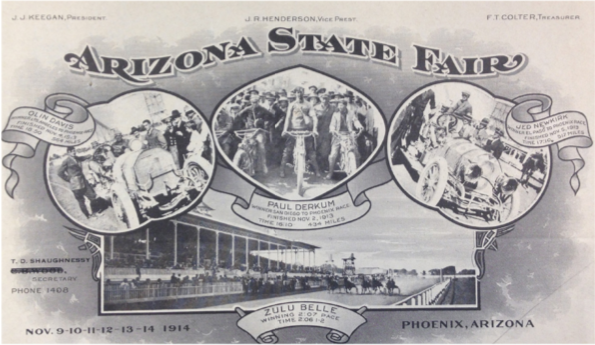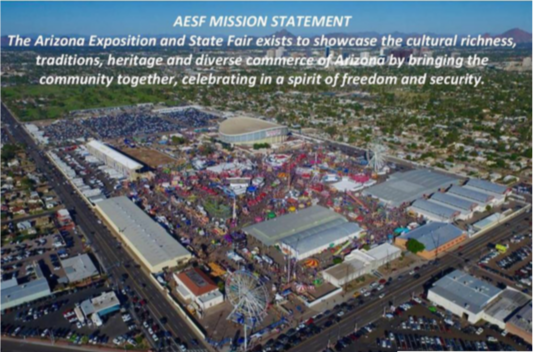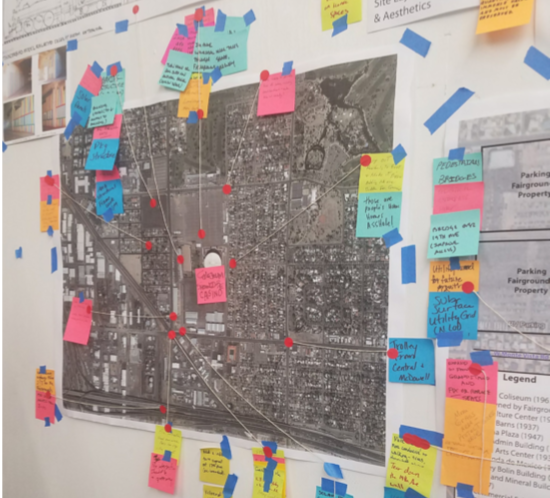The State Historic Preservation office has just released the results of a “charrette”, which took place last year at this time in an effort to begin to plan the future of the State Fairgrounds.
You can get a copy of that report here.
There is a lot of history and background to cover if you want to understand what’s going on here and why it is important.

But, before we do that and for those of you who don’t know what a charrette is, here is a definition from the report:
“A charrette is an intensive planning session comprised of formal and informal meetings, held over a short period of time for the primary purpose of collaborating on a vision for the future. Public agencies, private citizens, design professionals and stakeholders are encouraged to collectively formulate a plan for development and/or revitalization of a facility, urban area or neighborhood.”
To put this in to context, it’s important to know that our State Fairgrounds is owned by the State of Arizona, even though it is in the city of Phoenix. So, the Arizona legislature and the governor have the power to decide what to do with it.

Unfortunately, for decades the legislature and governor have failed to fully fund historic the preservation of the fairgrounds.
This has been true of both Republican and Democratic governors, although we have not had a Democratic Legislature since the 1960s.
Still, this has had a huge impact over the years. Neighborhoods that surround the fair are greatly affected by the condition of the property, and that has an impact on people’s property values.
So, it has been frustrating over the years to see that the legislature has even periodically swept funds from the State Fairgrounds, which could have otherwise gone to historic preservation.
In 2014, after decades of neglect, this came to a head when the fairground board made the choice to knock down the historic WPA Building on McDowell. This structure has important ties to the reforms of the 1930s that were meant to bring the US out of the great depression through the Work Projects Administration.
Many of us rallied and were able to stop the bulldozers. Since then, it’s been a long road on which we are continuing to try to find funding to begin renovations on the building, from city, state and private sources. We still have some way to go on that.
And, that is only one of many historic buildings on the property.
However, that event sparked a renewed interest in the fairgrounds. As the city has become more dense, people are starting to look at ways that the historic buildings and the entire fairgrounds could be put to use more often throughout the year.

Those changes get us to the Charrette. After some initial calls to the public for ideas, and fears that the governor’s office was thinking of selling the fairground land, the governor’s office began working primarily with the State Historic Preservation Office to generate ideas of what could come.
It is worth a few minutes to skim the report, as some of the ideas that came out of that weekend a year ago are very inventive. There is very little money to work with, and these creative community leaders came up with some great concepts.
In the end, we are left with two major directions we could take: move the fair or keep the fair.
If we move the fair, which people have spoken about for years, then it is in the best interest of neighborhoods in Central Phoenix to have some voice about what will happen to the space. Right up front, we need to protect the historic buildings.
After that, we will want to make certain that the space is complementary to the neighborhoods. For instance, I have been told by developers that the only way they could make the space work would be to build large apartment complexes there.
This would be a non-starter for many people, especially those in the homes right next to the fair. Many apartments are over three stories and would look down on the neighbors’ back yards, which carries many privacy concerns. Furthermore, many apartment buildings tend to lose their luster in only a decade or so. This could cause problems for the neighbors.

While we need more owner-occupied and affordable housing downtown, we would not be likely to get both, were this land to go to developers of condos.
They would likely be higher priced condos, packed on to the acreage of the old fairground, which would exclude many people who need affordable housing the most.
And, none of that addresses what would happen to the colosseum.
The best approach would be to prepare for the exit of the fair with an empowered working group of thinkers from the city, the state, the county, ASU, the historic coalition, developers, historic preservation experts and housing experts.
This is a decision that deserves visionary thinking.
Were the fair to stay in place, then many of these same interests should still convene to consider what that looks like, while improving and re-purposing some of the buildings.
Under this scenario –and perhaps even the first one– the many historic buildings could be re-purposed in a way that re-invigorates the state fairgrounds as a point of community pride.
One developer made a suggestion that I thought was powerful: turn the fairgrounds in to a Phoenix version of Millennial Park. This would require taking over the west 9 holes of the Encanto Golf course.
Regardless, the charrette report will give you a great insight in to the various challenges and opportunities of the fairgrounds.
It’s worth a read while you are waiting for the next episode of Game of Thrones to come on.









